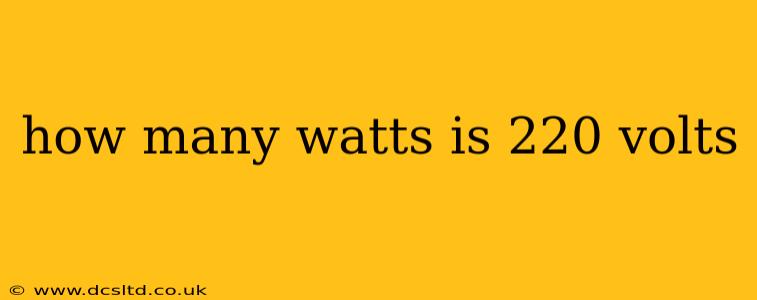How Many Watts is 220 Volts? Understanding Power, Voltage, and Current
The question "How many watts is 220 volts?" is a common one, but it doesn't have a single answer. Volts and watts represent different aspects of electrical power, and you need more information to determine wattage. Let's break down the relationship between volts, watts, and amperes (amps) to understand why.
Volts (V): This measures the electrical potential difference, essentially the "push" or pressure behind the flow of electricity. Think of it like water pressure in a pipe. 220 volts is a common voltage in many parts of the world, higher than the 120 volts used in North America.
Watts (W): This measures electrical power—the rate at which electrical energy is used or consumed. It's like the amount of water flowing through the pipe per unit of time. A higher wattage appliance uses more power.
Amperes (A): This measures the rate of electrical current flow—the actual amount of electricity flowing. It's analogous to the flow rate of water in the pipe.
The Key Relationship: Ohm's Law
The relationship between voltage (V), current (A), and power (W) is defined by Ohm's Law and its derived formulas:
- P = V × I (Power = Voltage × Current) This is the most relevant formula for answering your question.
- I = P / V (Current = Power / Voltage)
- V = P / I (Voltage = Power / Current)
Where:
- P = Power (Watts)
- V = Voltage (Volts)
- I = Current (Amperes)
To calculate the wattage, you need to know the amperage (current) of the appliance or device. This information is usually found on a label on the device itself. Once you know the amperage, you can use the formula P = V × I.
Example:
Let's say you have a 220-volt appliance with a current draw of 10 amps. The wattage would be:
P = 220V × 10A = 2200W
This appliance uses 2200 watts of power.
Frequently Asked Questions (PAAs)
Here are some frequently asked questions related to voltage, wattage, and amperage:
What is the difference between voltage and wattage?
Voltage represents the electrical pressure, while wattage represents the rate of energy consumption. Think of voltage as the water pressure in a hose, and wattage as the amount of water flowing through the hose per minute. You need both to understand how much power a device uses.
How do I find the amperage of my appliance?
The amperage (current) rating is usually printed on a label on your appliance. Look for a label that indicates amps (A) or sometimes just a number followed by an "A".
Can I use a 120-volt appliance on a 220-volt outlet?
No, this is extremely dangerous and could damage the appliance or cause a fire. Always ensure your appliance is rated for the voltage of your outlet.
Can I use a 220-volt appliance on a 120-volt outlet?
No. A 220-volt appliance will likely not work on a 120-volt outlet. It will either not turn on or may be damaged.
Is higher voltage always better?
Not necessarily. Higher voltage can transmit power more efficiently over longer distances, but it's also more dangerous. The appropriate voltage depends on the specific appliance and safety regulations.
How many watts can a 220-volt circuit handle?
The maximum wattage a 220-volt circuit can handle depends on the amperage rating of the circuit breaker protecting it. This is typically 15 amps, 20 amps or higher, but you must check your electrical panel. You can calculate the maximum wattage using the formula P = V × I.
In conclusion, you cannot determine the wattage of a 220-volt appliance without knowing its amperage. Always check the appliance's label for this crucial information to avoid electrical hazards and ensure proper operation. Remember to consult a qualified electrician for any complex electrical work or concerns.
